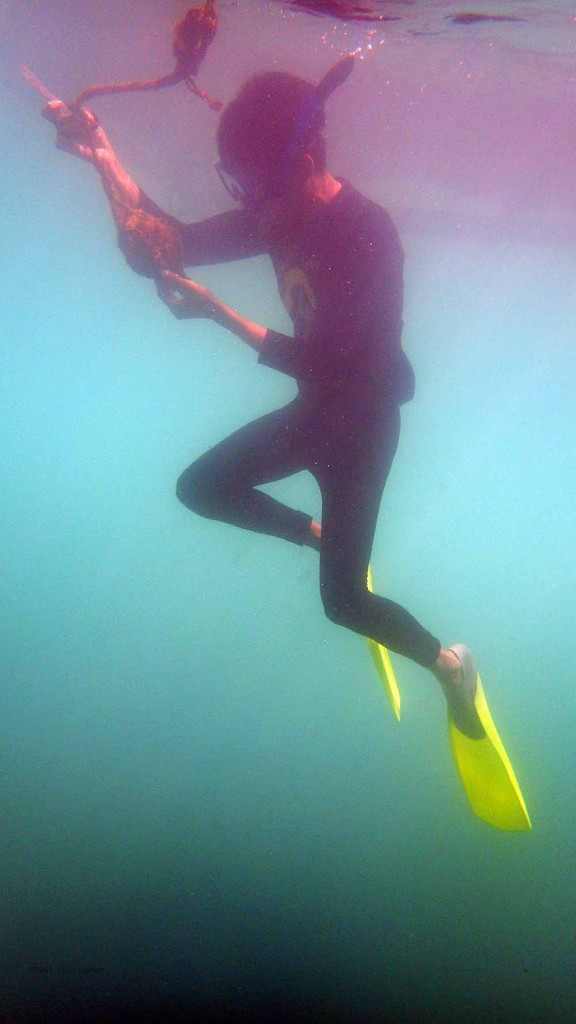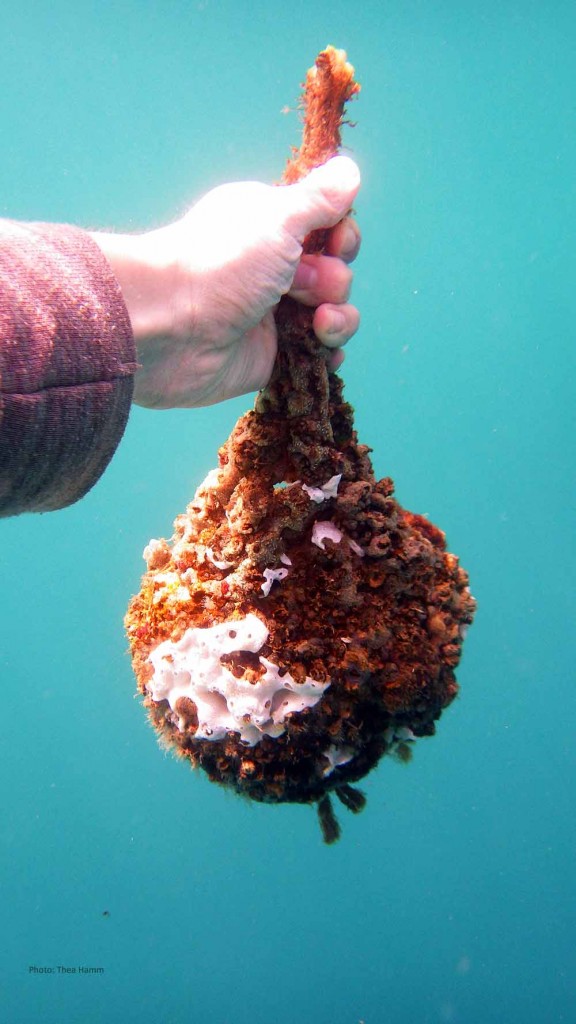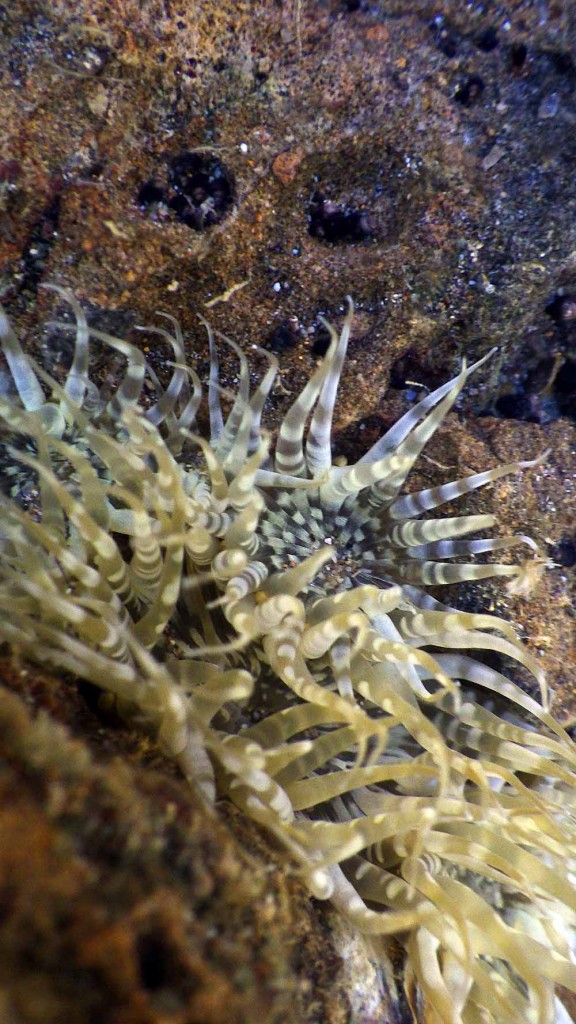Daily life begins really early here in the country of islands! Shortly before 5 am the call to prayer resounds through the whole city and Prehadi, my Indonesian counterpart, gets up to pray. I usually sleep a bit longer, but latest at 6 o’clock it is too loud outside to sleep comfortably and I get up as well, heat up some water and shower by pouring buckets of water over me. After a breakfast that usually consists of rice with fresh fruits and coffee, we meet in the lab to check our anemones and the daily work begins…
This year’s Team Indonesia consists of Prehadi from Jakarta who is doing his Master’s in Marine and Fisheries Sciences at Institut Pertanian Bogor, the Bogor Agricultural University, and Thea from Germany who is studying Biological Oceanography at GEOMAR in Kiel. We work in the Marine Habitat Laboratory in Bogor – what actually is a rather unusual place for a marine science laboratory, especially in a country that consists of more than 17 000 islands, since it is located not even close to the sea! This circumstance was quite a challenge for us, since each sampling day at the sea requires a lot of preparation and our working time at site is very limited due to the long travel. Our first sampling took place at Pelabuhan Ratu, which is a bay at the south coast of Java, approximately 60 km away from Bogor. That does not sound like a long distance, but if you have ever encountered Indonesian traffic, you will understand why we got up at 4 am to avoid the rush hour(s). After a long and bumpy journey through beautiful and mysteriously foggy rainforests, passing palm oil plantages and terraced rice fields, we finally reached the coast! At first, we were looking for intertidal anemones at a rocky beach and there Prehadi found our first species. This was very relieving since the search for anemones was another of our challenges. There are NO records AT ALL for anemones in Indonesia – at least when you are not looking for anemone fishes and their host anemones. If this is what you need, you will find plenty, but this was not our interest, so we were left without any information about the distribution of anemones along the coastline of Java.

Prehadi and Thea scratching the anemones out of tiny little cracks – closely observed by very curious little kids.
Now that we found a species, we carefully scratched some individuals from the stones and then went on to our next sampling station: Floating bamboo constructions, which are used by local fishermen for, e.g., the culturing of shrimps. Since these constructions stay in the water for a long time, we thought that they provide a good substratum for anemones that live in subtidal habitats. A local fisherman took us out with his boat, since the constructions are located from 20m up to several hundred meters away from the beach.
Then we started snorkeling and searched every centimeter of one of these constructions, but we mostly found ascidians, which overgrew everything out there, some barnacles, crabs and bryozoans as well as some fish and squids that searched for food at those floating islands. When the waves became too high to work properly, we almost gave up for the day, but then Mareike, a GEOMAR PhD-student at IPB who is helping us, spotted tiny whitish anemones on a stone hanging down from the construction to stabilize it in the water! Since scratching them off was impossible, we were allowed to cut the whole stone from the construction and the fisherman attached a new stone to keep the construction stable. Back at the beach we even found a population of a third intertidal species that colonized a single rock and we took some more individuals from there for the lab. Very tired, but extremely relived that our first trial was so successful, we went back home for that day. The next days were filled with more field trips to search for other places at which we could find anemones – either of the same species that we already had or of another species. This was necessary, because we wanted to have a higher genetic diversity in our experimental population and more species in case the ones we found are not suitable for lab work. After some – compared to the first one – rather unsuccessful trips, during which we could not find anemones in suitable numbers and after having found one species that did nothing but dying away under lab conditions, we decided to take the first anemones we found and went back to Pelabuhan Ratu to collect more individuals for our experiments. Since one of our species could actually be only found on these stones hanging down from the bamboo constructions, we went from one construction to the other until we had enough individuals for our experiment.

Prehadi searching for our second species on a stone hanging down from one of the bamboo constructions.

And successful! A stone that hung in the water for a very long time and is already completely overgrown with animals. One of which is our target organism!
By now, the anemones are fully acclimated to the lab conditions and we already have a good routine in changing the water manually every day and culturing Artemia to feed the animals. Since we only have two big storage tanks containing 2000l of seawater each, we cannot use a flow-through system like most of the other GAME teams do. We have to recycle our water and need to be careful not to lose too much of it on the way.
Now we are doing test trials to find the best way to measure our response variables so that everything will run smoothly during the pilot and main study. This is not always easy, since not all of the response variables that we agreed on during the preparation course in Kiel are applicable to the anemones we have. However, since we want to compare our results to those from the other stations in the end, we need to communicate a lot about the choice of the response variables and the way how to measure them.
But apart from the laboratory, there is a lot to discover in Indonesia! Bogor is located in the west of the Island of Java and just south of the capital Jakarta. It lies in a hilly area with rain forests and the volcano “Mount Salak” rising over the city. It is famous for its many beautiful waterfalls, which are located just outside the city. Other than that, Bogor is a nice place to live, many people who live here actually work in Jakarta and commute every day. In the city center is a very big and famous botanical garden with lots of deers and the presidential residence. Bogor is also home to the very good Bogor Agricultural University, with one campus in the city close to the botanical garden and our campus, which is a little bit outside the city, but therefore very green and comfortable to work and live at.
Indonesia’s official language is Bahasa Indonesia which is actually not the mother tongue of most Indonesians but was established as an official language to unite the country without favoring a major ethnicity. It also serves to facilitate communication since almost every big island has its own language and also its own culture. In the region of Bogor the most common languages are Sundanese and Javanese, but at the university mostly Bahasa can be heard. It is the official teaching language and there are many students who come from other parts of Indonesia such as Sumatra, Kalimantan (Borneo) or even Papua.
In Indonesia five religions, Islam, Christianity, Hinduism, Buddhism and Confucianism, are officially approved and coexist. This means, for example, that all religious holidays are respected, what results in a lot of holidays over the year! But most people are Muslim and this religion dominates the society the most. For example now that the Ramadan has started, life becomes a little bit different here. The cafeteria, where we usually eat, is closed and all other restaurants as well. University finishes a little bit earlier than usual and in the evening you see more people than usual in the mosque to pray. After sunset all the restaurants are open again and all people rush to finally eat something after a long day.
Coming here as a foreigner or “bule” can still put you in funny situations here. Not so much in Jakarta but already in Bogor and especially in more rural areas, where people watch you curiously and ask a fast set of more or less random questions like “Miss! Where are you going? Where are you from? What’s your name? How old are you Miss? Are you married? How many children do you have? Picture please?”. But whenever some help is needed, which is sometimes even the case when I want to cross a street, there will be someone to help me.
Now, there are still four month of our research stay left in this amazing country full of surprises and breathtaking sunsets and we work every day to return to Kiel with interesting results!
Prehadi and Thea






